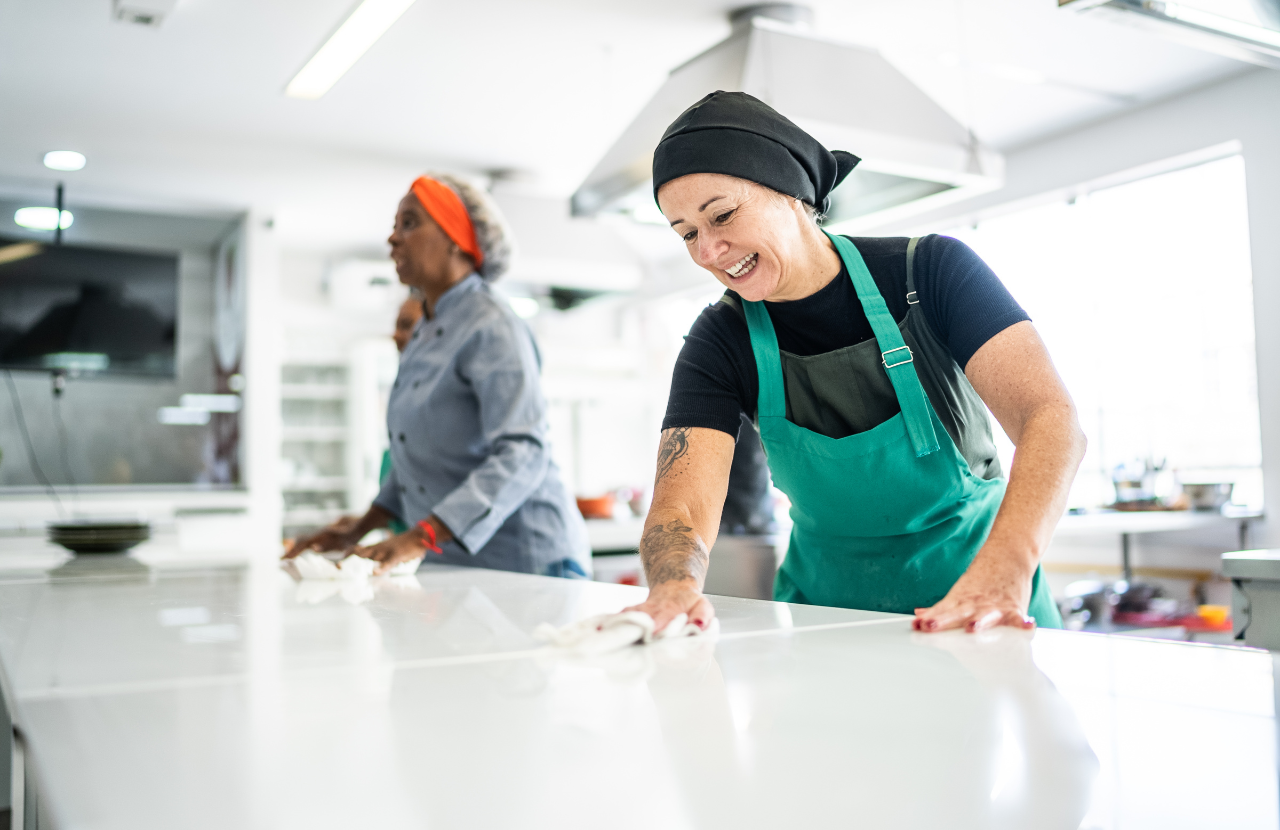
Effective food safety requires proactive, continuous hygiene management during every step of food preparation. Understanding how to implement and maintain ‘clean as you go’ practices is essential for creating a safer, more efficient kitchen environment.
In this guide, we discuss the importance of ‘clean as you go’ and how to integrate it into kitchen operations. You will gain practical insights that can be immediately applied to improve hygiene standards, streamline workflow, and support compliance across your team.
What does clean as you go mean in the kitchen?
‘Clean as you go’ means that food handlers control hygiene risks continuously while carrying out their duties, rather than waiting until a quieter moment or the end of service.
What does clear and clean as you go mean?
Some organisations use the phrasing ‘clear and clean as you go’. This simply adds a sequence: clear first (remove waste, packaging, unused items), and clean second (apply detergent and/or disinfectant). This distinction can improve consistency in fast-paced environments.
Why is clean as you go critical to health and safety?
Clean as you go reduces the likelihood of:
Cross-contamination between raw and ready-to-eat foods
Raw poultry, raw meat, raw fish and unwashed produce may contain harmful microorganisms such as Campylobacter, Salmonella or certain strains of E. coli.
If the same board, knife or work surface is used again without effective cleaning, those microorganisms can transfer directly onto ready-to-eat foods like cooked meat, salads, breads or desserts. As those foods will not undergo a final heat step, any pathogens present will enter the person’s system.
The consequences can be severe:
- Campylobacter is the most common cause of foodborne illness in the UK and is responsible for thousands of hospital admissions per year.
- Salmonella infection can also cause diarrhoea, fever and abdominal cramps, and in severe cases can result in dehydration, bloodstream infection (sepsis) or even death.
- Certain strains of E. coli, particularly Shiga toxin-producing E. coli (STEC), can cause bloody diarrhoea and can develop into haemolytic uraemic syndrome (HUS), a condition that may lead to kidney damage or be life-threatening.
Clean as you go controls break this chain by removing contamination at the point it occurs.
Allergen transfer
Even extremely small traces of allergens can cause life-threatening reactions. It is not just visible residues that matter, microscopic amounts can be enough to trigger anaphylaxis.
Natasha’s Law, introduced in 2021 following the death of Natasha Ednan-Laperouse from an undeclared allergen (sesame) in a pre-packed food for direct sale, demonstrates why controls must be taken seriously.
Clean as you go practices help prevent cross-contact by ensuring utensils, boards and surfaces are never used for multiple food types without cleaning and sanitising in between.
Bacterial spread
Bacteria do not stay static; they multiply. At ambient temperatures (this means room temperature which is around 20°C to 25°C), many foodborne pathogens double roughly every 20 minutes. This means a very small contamination event can escalate to an unsafe bacterial level within the duration of a normal service period.
Some foods become high-risk because bacteria or bacterial spores can survive the cooking process. A common example is cooked rice. Uncooked rice grains often carry spores of Bacillus cereus. These spores can survive cooking, and if the rice is then left at room temperature, the spores can germinate, multiply rapidly, and produce toxins which are not destroyed by reheating.
Other bacteria can cause illness in different ways:
- Staphylococcus aureus can produce a heat-stable toxin that causes rapid and severe vomiting, often within hours of eating contaminated food. This is often linked with foods handled a lot by hand such as sliced meats, cream-filled pastries, sandwiches and salads.
- Listeria monocytogenes is especially dangerous for pregnant women (risk of miscarriage or stillbirth) and for people with weakened immune systems. It can also grow at refrigeration temperatures. Higher-risk foods include soft cheeses (especially unpasteurised), pâté, smoked fish and ready-to-eat deli products.
- Clostridium perfringens is often linked to mass-catering outbreaks, where large batches of food cool too slowly. High-risk foods include stews, casseroles, gravies, stocks, curries and roasted meats cooked in bulk.
Continuous cleaning removes food residues that bacteria can grow on and limits the conditions that allow illness-causing organisms to flourish.
Pest attraction
Food debris, sugary residues, grease and open waste all act as attractants for pests including flies, rodents and cockroaches. Once pests enter a food area, every movement they make spreads contamination — not only with microorganisms but also with droppings, urine and fur. These can transfer pathogens onto food and food contact surfaces, which can then cause foodborne illness in customers and staff.
Some of the diseases associated with pests include gastrointestinal infections, parasitic infections, and infections caused by bacteria such as Salmonella and E. coli. Even small-scale pest activity can therefore lead directly to illness if contamination reaches food.
A single pest presence incident in a food business can lead to immediate closure by Environmental Health, reputational damage and significant cost. Clean as you go helps prevent pests ever being drawn into the environment by removing accessible food sources and making the working environment inhospitable to them.
Slips, trips and falls
Spillages and dropped packaging must be dealt with immediately. Slips frequently occur in kitchens when oil, batter, sauces, ice or drink spillages are left on the floor. These incidents can result in significant injury, lost working time and liability costs for the business.
Slips and trips are a common cause of injury for chefs and catering staff in commercial kitchens. For example, compensation was awarded to a kitchen worker who slipped on oil and food debris left on a kitchen floor, resulting in injury and legal action against the employer.
How does clean as you go support legal compliance?
Clean as you go helps businesses meet the Food Hygiene (England) Regulations 2006, ensuring food is prepared, handled, and stored in hygienic conditions. It also supports compliance with the Health and Safety at Work Act 1974, which requires employers to maintain a safe working environment. By clearing waste and cleaning up spills promptly, businesses reduce the risk of slips, trips, and falls.
How to implement clean as you go
Clean as you go is most effective when it is built into normal kitchen workflow. The following actions set out how continuous cleaning should be carried out in practice:
Wipe down benches, chopping boards, knives, and equipment between tasks
Food contact surfaces and tools must be cleaned and sanitised every time you change food type, switch from raw to ready-to-eat foods or complete a stage of preparation.
Use a designated cleaning cloth or disposable wipe and apply the approved cleaning agent or sanitiser according to the product’s instructions. Ensure that boards, knives, trays, utensils, and other equipment are visibly clean and fully sanitised before starting the next activity. This prevents residues such as raw meat juices, allergens, or other contaminants from being transferred to the next product.
Deal with spills immediately
Any liquid, semi-liquid, or loose food items that fall onto work surfaces or floors must be cleaned up straight away.
Use disposable paper roll on raw spillages to remove bulk material before applying detergent or sanitiser. Floors should not be left wet; clean and dry them promptly to avoid slips. A small spill kit or disposable wipes should be positioned in the prep area so that immediate action is practical.
Remove packaging, food debris, and waste from the workstation promptly
Packaging (such as cardboard or plastic film), peelings, offcuts, empty containers, and general debris should be cleared from the prep area as soon as they are redundant.
Waste bins and recycling containers should be positioned close enough to the workstation to make disposal convenient. Do not allow waste to build up on benches, window ledges, equipment trolleys, or in trays, as this creates hygiene issues and obstructs workflow.
Keep cleaning materials accessible and use them throughout service
Cloths (colour coded if required), detergent sprays, sanitisers, and disposable wipes should be stored in a location that can be reached without leaving the work area. Products should be clearly labelled and used as intended.
Make sure cloths are not left soaking in dirty buckets – these should be changed frequently or replaced with disposable options. Refilling or replacing products should be part of the normal service routine, not only a closing task.
Sanitise food contact surfaces at routine intervals
Sanitising should be undertaken both reactively (when contamination occurs) and proactively at agreed points in the workflow. This might include between prep batches, on change of food type, before handling ready-to-eat products, and after allergen handling.
Use sanitisers that meet the required microbiological performance standards and follow the required contact time to ensure they are effective. Wiping off a sanitiser too soon can significantly reduce its ability to kill microorganisms.
Highfield Level 3 Food Safety: drive safer practice
Embedding clean and as you go principles effectively requires confident supervision and a strong understanding of why safe systems of work matter.
Our Level 3 Food Safety course, accredited by the Highfield Awarding Body for Compliance (HABC), builds that deeper knowledge. The programme covers food safety management systems, HACCP, hazard analysis and current legislation, and develops the skills needed to implement and monitor robust food safety controls within the workplace.
Highfield Level 3 Food Safety can be delivered via eLearning, face-to-face at a venue of your choice, or through a virtual classroom. Find out more about the course from our website or contact us on 0203 011 4242 / info@praxis42.com

Adam Clarke
Managing Director (Consulting)
